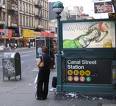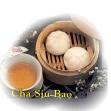 Places to Visit in ChinatownCHATHAM SQUARE
Places to Visit in ChinatownCHATHAM SQUARE (off Bowery and Worth Street), also known as Kim Lau Square is the site of the Kim Lau Memorial Arch found in the middle of the square. It was erected in 1962 in memory of the Chinese Americans who died during WWII. East of the square on Division Street is Confucius Plaza, where a statue of the philosopher stands.
FIRST SHEARITH ISRAEL CEMETARY is just south of Chatham Square. It is the oldest cemetery and artifact in New York City, dating back to 1683.
FUJIANESE EAST BROADWAY is the heart of the new Fujianese community. In this three-block area around the Manhattan Bridge there are Fujianese rice-noodle shops, herbal medicine shops, fresh markets and hair salons.
DOYERS STREET is a picturesque narrow elbow-shaped street just north of Chatham Square. It has been featured in numerous movies and TV shows.
MOTT STREET is where visitors can truly feel the hustle and bustle of Chinatown. A plethora of banners and signs with Chinese writing, some of Chinatown’s most popular restaurants and shops, and the rhythms of Mandarin and Cantonese dialects fill this narrow street. The oldest street in Chinatown inhabited by the Chinese, it is also the site of the Chinese Community Center and the Eastern States Buddhist Temple of America. The street is also home to 32 Mott Street (where the oldest shop in Chinatown used to stand – established in 1891), and 41 Mott Street (the only building that remains with a wooden pagoda roof).
FIVE POINTS (at the intersection of Mosco, Worth and Baxter Streets), it was named for the intersection of the five streets that converged at the south end of what is now Columbus Park. It is was also the site of the city’s first tenements built to accommodate immigrants from Germany and Ireland.
MUSEUM OF CHINESE IN THE AMERICAS offers special exhibitions on the history of the Chinese in the U.S. Exhibits feature personal stories, photographs, mementos, and poetry.
COLUMBUS PARK, situated just half a block south of the museum, is Chinatown’s major park. Created by Jacob Riis, a social reformer in the late 1890s, the public space is used by groups practicing tai chi, mahjong players, children and elderly men and their pet birds. On some weekends fortunetellers can be found here as well.
PELL STREET is nicknamed “Haircut Street” because of a multitude of barber and beauty shops found here. The headquarters of the Hip Sing Business Association is located on this street and a Buddhist Temple is just a stone’s throw away. This temple is mainly for visitors; worshipping Chinese opt for more secluded and quieter temples.
EDWARD MOONEY HOUSE is the oldest residence in New York and is found on at the corner of Bowery and Pell Street. Built in 1785 by Edward Mooney, an amateur butcher, today it houses the Summit Mortgage Bank.
CHURCH OF THE TRANSFIGURATION was erected in 1801 by the English Lutheran Church and sold to the Roman Catholic Church of the Transfiguration in 1853. It served as a place for new immigrants to become adjusted to their new lives and today offers services in Cantonese, Mandarin, and English.






